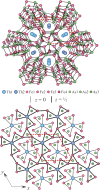Thorium-Based Iron Arsenide with Fe-Fe Bonding
- PMID: 41060966
- PMCID: PMC12541701
- DOI: 10.1021/acs.inorgchem.5c02207
Thorium-Based Iron Arsenide with Fe-Fe Bonding
Abstract
This work presents a study on a new thorium iron arsenide, Th2Fe12As7, a second discovered compound in the ternary system. It crystallizes in the noncentrosymmetric hexagonal Zr2Fe12P7 structure type (space group P6, a = 9.5506(4) Å and c = 3.8645(2) Å). The bonding analysis of Th2Fe12As7 reveals that the structure can be represented by a trigonal prismatic environment of the As atoms, which are the geometric locations of anionic components of the structure. The cationic components of the structure are represented by the Th species. Furthermore, the bonding analysis revealed a new feature─a three-dimensional framework of two-atomic bonds between the Fe atoms, which─in the sense of effective charges─is essentially neutral. It plays the role of a bonding mediator within the [Fe-As] framework. Th2Fe12As7 is a metallic paramagnet down to the lowest measured temperature, 0.4 K.
Figures








References
-
- Cotton, S. The Actinides; Macmillan Education: UK, 1991; pp 85–169.
-
- Wickleder, M. S. ; Fourest, B. ; Dorhout, P. K. . Thorium; Springer: Netherlands, 2008; pp 52–160.
-
- Ott, H. R. ; Fisk, Z. . Actinides: Superconducting Materials; Wiley, 2018; pp 1–14.
-
- Liu Y., Li J., Yang W.-Z., Lu J.-Y., Cao B.-Y., Li H.-X., Chai W.-L., Wu S.-Q., Li B.-Z., Sun Y.-L., Jiao W.-H., Wang C., Xu X.-F., Ren Z., Cao G.-H.. Superconductivity in kagome metal ThRu3Si2 . Chin. Phys. B. 2024;33:057401. doi: 10.1088/1674-1056/ad1c5e. - DOI
LinkOut - more resources
Full Text Sources
Research Materials

